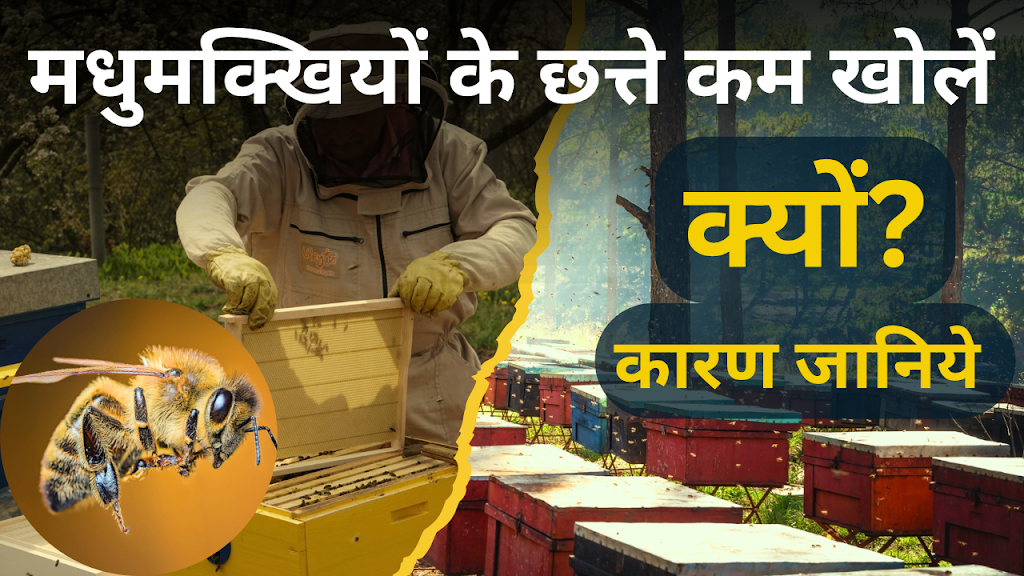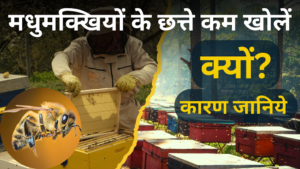छत्ते को बार-बार खोलने की बजाय मधुमक्खियों को प्रवेश द्वार से देखना एक समझदारी और मधुमक्खी-हितैषी तरीका है। इसके कई फायदे हैं:
1. मधुमक्खियों पर कम तनाव: बार-बार छत्ता खोलने से मधुमक्खियां परेशान हो जाती हैं। उनके काम में रुकावट आती है। बाहर से देखने पर वे अपनी दिनचर्या में व्यवस्थित रहती हैं।
2. तापमान और नमी का संतुलन: छत्ते के अंदर का तापमान और नमी का संतुलन बहुत जरूरी होता है, खासकर बच्चों (ब्रूड) और शहद के लिए। बार-बार छत्ता खोलने से यह संतुलन बिगड़ सकता है, जिससे नुकसान हो सकता है।
3. बीमारियों का खतरा कम: बार-बार छत्ता खोलने से बीमारियां या कीट, जैसे वररोआ माइट्स, फैलने का खतरा बढ़ जाता है। कम छेड़छाड़ करने से यह जोखिम कम हो जाता है।
4. समय की बचत: बाहर से देखकर आप छत्ते की स्थिति का अंदाजा आसानी से लगा सकते हैं। जैसे – मधुमक्खियों का पराग लाना, पहरेदार मधुमक्खियां, उड़ान की गतिविधियां, ये सब उनके स्वस्थ होने के संकेत दे सकते हैं।
5. प्राकृतिक व्यवहार को प्रोत्साहन: छत्ते को बार-बार खोलने से मधुमक्खियों का स्वाभाविक व्यवहार प्रभावित होता है। बाहर से देखने पर वे अपने प्राकृतिक तरीके से काम करती हैं, जो उनके स्वास्थ्य के लिए अच्छा है।
6. मधुमक्खी पालक के लिए सुरक्षित: कम छत्ता खोलने पर मधुमक्खियां गुस्सा कम करती हैं, जिससे पालक के लिए भी यह तरीका सुरक्षित बनता है।
प्रवेश द्वार से क्या देखें?
• पराग (पॉलन): मधुमक्खियां पराग लेकर आ रही हैं तो इसका मतलब है कि छत्ते में बच्चों की परवरिश हो रही है।
• उड़ान गतिविधि: मधुमक्खियों की लगातार आवाजाही से पता चलता है कि छत्ता स्वस्थ और सक्रिय है।
• पहरेदार मधुमक्खियां: प्रवेश द्वार पर पहरेदार दिखें तो समझें छत्ता सुरक्षित है।
• मलबा: छत्ते के पास गिरे मलबे या मरी हुई मधुमक्खियों पर नजर रखें, यह बीमारी या कीटों का संकेत हो सकता है।
निष्कर्ष
छत्ते को कम खोलने और प्रवेश द्वार से निरीक्षण करने का तरीका अपनाकर आप मधुमक्खियों के स्वास्थ्य और उत्पादकता को बेहतर बना सकते हैं। यह न केवल मधुमक्खियों को लाभ पहुंचाता है बल्कि मधुमक्खी पालक के लिए भी एक आसान और सुरक्षित तरीका है।


